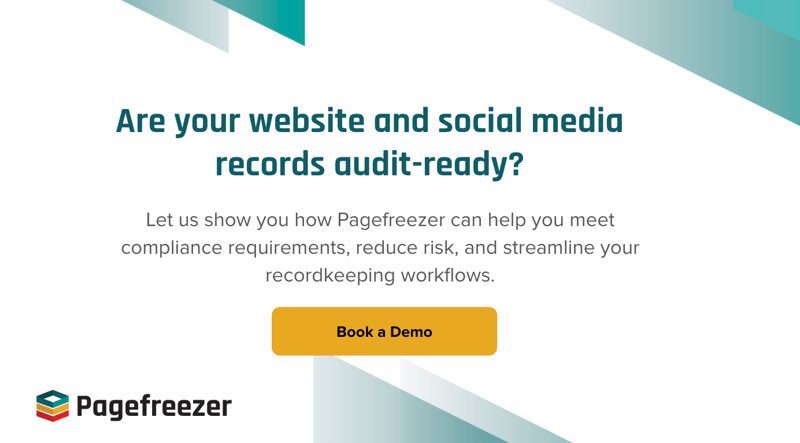Every department within an organization has a different workflow but shares one mutual frustration: compliance management.
All personnel, from executives to HR staff, must adhere to established rules when creating internal policies. A few misplaced records could result in hundreds of thousands of dollars in penalties, while a cyberbreach can impact the bottom line for the foreseeable future.
It doesn’t help that regulations are always changing and growing.
Organizations could once get away with paying the occasional fine, but today, investing in compliance management is not optional. It’s now a foundational requirement to protect your organization from heavy losses, litigation, and reputational collapse.
This article outlines what compliance management is, along with a few best practices to help you get started in this area. It also highlights the roles of management software and tools like Pagefreezer in taking proactive measures.
Understanding Your Compliance Needs
Regulatory frameworks exist to ensure an organization operates within the rules. In practice, this can mean many different things depending on your industry.
In the financial sector, for instance, regulatory bodies dictate how a firm handles customer data, documents transactions, and client communications. In healthcare, they govern how hospitals store patient information. Government bodies are bound by rules on how they preserve records and demonstrate transparency.
The first step, accordingly, is to identify where your individual requirements lie. A compliance audit may offer relevant insight into the specific policies, processes, and procedures you need to implement—and how to monitor and maintain them.
Some regulatory needs, however, remain the same regardless of industry.
Archiving and recordkeeping
Recordkeeping is one such regulatory matter. Almost all highly regulated organizations must maintain detailed archives of business activities. In the digital age, the definition of records has broadened significantly. Proving adherence to recordkeeping guidelines could require you to produce chats from Microsoft Teams or screenshots of now-deleted social media posts. Firms must have a plan in place to store defensible and audit-ready records at all times.
Compliance monitoring
Staying on top of changing compliance trends is a task that often requires entire teams to mobilize quickly. Organizations must create systems and processes to continuously monitor the regulatory landscape, as well as their own compliance status. They must conduct regular audits, analyze the data, and monitor activity across departments.
Compliance management software
Many, if not most, organizations turn to technology for modern compliance management solutions. Compliance management software brings order and automation to a process that once lived in scattered spreadsheets and departmental silos. Last year, the market for compliance management software was valued at $11.18 billion. It’s projected to grow to $18.37 billion by 2029.
These systems are invaluable, considering they can centralize data, automate workflows, and map policies. In the event of a rule change—such as a GDPR amendment or a FINRA update—the software flags affected policies, notifies owners, and triggers reviews.
Best Practices for Compliance Management
Despite growing regulatory pressures and rising penalties, many organizations continue to fall behind on compliance management.
A recent survey of 200 companies found that over half compromised on compliance due to business pressures—and another 79% admitted they’ve skipped compliance checks on customers for fear of damaging client relationships.
That practice is no longer sustainable. Whether it’s Volkswagen’s $33.3 billion hit for Environmental Protection Agency-related violations in 2015, or JP Morgan’s $3 million penalty for misreporting shares, it’s clear that the cost of non-compliance can be incredibly high. And those are just the direct costs. Organizations must invest in these best practices and build a forward-looking compliance framework.
1. Conduct comprehensive risk assessments
A formal risk assessment is the critical first step, serving as a diagnostic tool to identify where your organization is most vulnerable. This process involves systematically mapping your operations against the regulatory landscape.
Is your customer data storage method a potential liability under new privacy laws?
Could an informal, ephemeral communication on a messaging app constitute a recordkeeping violation?
By conducting a thorough risk assessment, you can prioritize your efforts and allocate resources where they matter most.
2. Establish clear procedures and policies
A misunderstood policy is as bad as no policy at all. Once risks are identified, they must be countered with clear, accessible, and actionable plans. These policies must promote consistency in decision-making. They must also ensure managers and employees are held accountable for their actions and decisions—and reduce the time spent on confusion or disputes.
Organizations must also be careful to draw a sharp distinction between policies and procedures. The former provides guidelines or a framework within which decisions are made, while the latter simply informs someone how to perform their job. Both must be clear and concise to empower your team to make the right decisions.
3. Monitor progress and perform regular audits
Compliance is not a project with an end date. It is a continuous cycle, as the regulatory environment is in constant flux, and your internal operations evolve daily. Organizations can no longer afford to rely on once-a-year audits.
Instead, you must implement systems to ensure continuous monitoring. This proactive approach involves constantly scanning for updates, tracking key performance indicators, and periodically testing controls. Investing in monitoring and auditing allows you to catch deviations early, remediate issues before they escalate, and demonstrate a culture of ongoing diligence to regulators.
4. Train and empower staff
Technology and policies provide the framework, but it is your people who must practice it. Comprehensive, role-based training is therefore non-negotiable. This involves creating engaging training that explains the real-world consequences of non-compliance.
Furthermore, your compliance management policies must empower your employees to act and foster a culture where they feel comfortable reporting potential issues without fear of reprisal. When your team understands their role in protecting the organization, they become your most valuable compliance asset.
5. Create a response plan
In the worst-case scenario—one in which all systems fail to detect a potential violation—your organization must be prepared to react. Teams should be briefed on how to respond when any number of things go wrong. Organizations that establish clear policies and procedures to react to a cybersecurity breach, for instance, can restore operations much quicker—protecting themselves from losses to reputation and the bottom line.
Creating an iterative response plan that grows with your organization improves your resilience to future threats, as well. It ensures that you’re ready and compliant, regardless of whether the regulations suddenly shift or your operations scale and evolve.
Benefits of Proper Compliance Management
If you’re still deciding whether to invest in compliance management software, it’s time to look beyond purely financial considerations. Proper compliance policies give you fewer legal headaches, less manual work, and more clarity when making decisions. It also shows customers and partners that you’re serious about doing things right.
Here are just some of the benefits you can expect to get out of investing in the right tools:
- Reduced legal risk: Robust compliance systems have built-in safeguards that catch vulnerabilities before they become liabilities and generate defensible audit trails that prove your compliance when it counts.
- Greater trust: Today’s customers, partners, and investors want proof that you take data protection and compliance seriously. Compliance management software demonstrates your commitment and builds credibility.
- Better decision-making: As per a 2025 PwC global compliance survey, nearly 60% of all leaders said the biggest benefit of compliance management was better decision-making. When all policies, risks, and responsibilities are centralized in one platform, you can gain a clearer view of the full picture.
- More automation: Compliance management tools come with automated capabilities that save hours of manual work and reduce reliance on scattered spreadsheets or disconnected systems.
Compliance management does more than help you avoid penalties; it strengthens your entire organization. It sharpens oversight, improves culture, and positions your business to grow with confidence in an increasingly regulated world.
The Role of Recordkeeping with Pagefreezer
Tools like Pagefreezer address a critical, yet under appreciated aspect of compliance management: recordkeeping.
All highly regulated organizations are expected to maintain detailed records of all business activities, whether conducted online or in boardrooms. These rules are outlined by industry-specific bodies, such as the FINRA and SEC, as well as consumer protection laws like the GDPR or the Freedom of Information Act. They could also include a wide range of labor laws, such as worker safety acts and anti-discrimination legislation, among others.
Regulators typically expect organizations to maintain documented proof of all online conversations. They also need to know the context: who said what, when, and why? Moreover, these records must be proven to be unaltered, verifiable in court, and presented in very specific formats.
Archiving tools like Pagefreezer help you meet all these requirements.
Pagefreezer captures and stores records in their native format from a wide range of sources, including web pages, collaboration tools, and social media. It stores each record along with the original metadata, hash values and digital signatures, which proves its authenticity during audits. This immutable nature also ensures records can be presented in court for eDiscovery or as part of a records request.
These were once all practices that were carried out manually, painstakingly, and in conjunction with other compliance management practices.
Learn how Pagefreezer can simplify and automate the process by scheduling a demo.









